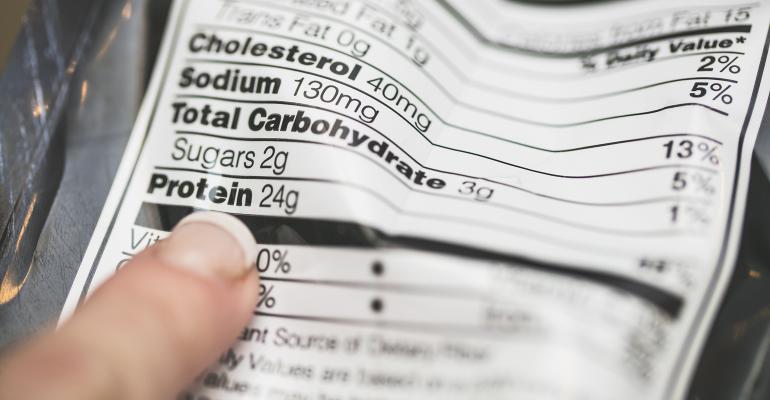Sponsored by TransAct Technologies, Restaurant Solutions
Foodservice operators are increasingly embracing grab-and-go prepared food offerings as a convenience for their customers seeking a quick meal or snack solution.
In order to make the customer experience as frictionless and expedient as possible, some operators are posting nutritional information for each grab-and-go item directly on the labels. That saves on-the-run diners from having to search online or elsewhere in the store for that information and eliminates the need for operators to create new menus or nutritional information displays every time they change an item.
New nutrition fact panels
Beginning in 2020, nutrition fact panels for grab-and-go prepared food items will need to adhere to new FDA guidelines, including the use of larger, bolder type for serving size and calories, more accurate serving sizes, and the addition of a new callout for added sugars, among other changes.
Many foodservice operators have already begun posting nutritional fact labels on their grab-and-go prepared items, says Rebekah Spetnagel, dietitian and cofounder of On The Menu, a Denver-based firm which provides nutritional analysis of menu items for restaurant operators.
“By law, they only have to post the calories, but most are doing the full nutritional label,” she says.
Her clients tell her that customers have been requesting more and more nutritional information about menu items, Spetnagel says.
For some items, it might make sense for restaurants and convenience store operators to post the full nutritional breakdown on the company’s website, and about half of On The Menu’s clients have done so, Spetnagel says. But for grab-and-go items, posting nutritional information on the label itself often supports the objective of providing convenience to customers.
“You want to make this a self-service area, and if you have someone coming up to an employee and asking for the nutritional information, it’s obviously not as efficient,” says Miguel Ortiz, director of marketing for restaurant solutions at technology and printing solutions company TransAct Technologies. “Our customers want to have that information there for the consumer.”
It’s also not practical for operators to print custom labels for every grab & go item, which can go out-of-date quickly and require supply chain to keep track of inventory on yet more SKUs.
Following are some of the advantages of using an automated system for managing nutrition labels on grab-and-go foods:
1. Flexibility
To maximize efficiency, restaurant operators often need to change their recipes and switch ingredients periodically, especially items such as grab-and-go sandwiches and salads that often feature seasonal ingredients. Having the ability to custom print labels on demand helps operators to meet FDA requirements quickly and efficiently. Printing on demand also eliminates waste generated from unused pre-printed labels and streamlines the label inventory in the restaurant.
“In many cases, our customers have gone from having a shower curtain rod full of labels to having one label SKU, and printing on demand as needed,” says Ortiz.
To add some branding to their labels, often companies have their logo and other information pre-printed on the labels in color, and use TransAct’s printing technology to add the calorie and nutrition information in black and white to the labels as needed.
2. Transparency
Posting nutritional information directly on grab-and-go food items also helps reinforce a message of transparency. Consumers, especially younger ones, are more conscious of nutritional content than ever and expect the companies which prepare their food to provide that information.
Nearly two-thirds of consumers — 64 percent — say they believe that restaurants should provide nutritional information for their products, similar to the requirements for packaged goods sold at grocery stores, according to a Reuters/Ipsos poll conducted last year.
The desire for transparency among young consumers is especially evident at fast-casual restaurants and on college campuses, where posting ingredient information has long been a common practice.
At the University of California-San Francisco, for example, students can go online to look up the ingredients, nutritional information and allergens for each item available each day through UCSF Dining. In addition, items are coded as being vegetarian, vegan, gluten-free or local/sustainable, and items which meet the UCSF criteria as “Smart Choice” selections are also indicated.
“We also provide nutrition information at our retail outlets by displaying nutrition facts on digital boards, receipts, and on our grab-and-go labels,” UCSF Dining says in a statement.
3. Scale and versatility
In order to optimize efficiency, operators should consider labeling systems which allow them to integrate with other systems and connect with their network of locations.
Operators should have the ability to input nutritional data just once for each grab-and-go menu item, then share that information with the other outlets where the item is offered, says Ortiz of TransAct.
“Our solution allows you to load all this information over the web, and it is automatically sent to all of the units in your install base,” he says. “Then you print grab-and-go labels on demand.”
The system can also serve multiple functions in the back-of-the-house, including providing date-code labels for prepped items in storage. It also has a screen which can be used for viewing digital recipe cards or training videos, among other functions.
With opportunities growing in grab-and-go prepared foods, operators need to consider solutions which not only ensure compliance with labeling requirements, but also enhance the customer experience and provide back-of-the-house efficiencies. Automated label printing can play a key role in the successful operation of a grab-and-go program which meets the needs of today’s consumers.



